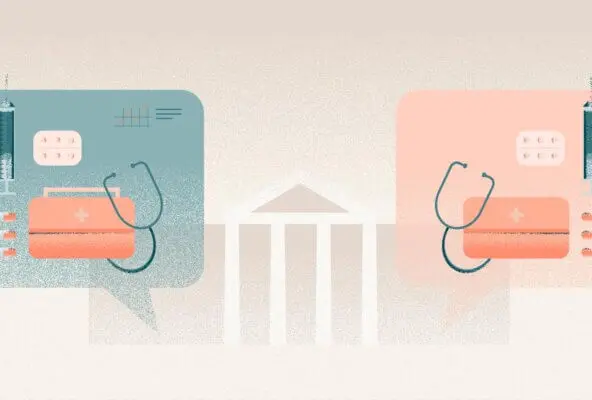Overview
- We are facing a potential “tripledemic” of COVID-19, influenza, and RSV this flu season. Preventative measures like vaccination, masking, handwashing, and staying home when sick are critical to reduce illness.
- Physicians should encourage vaccination among staff and patients to boost immunity. Offering on-site clinics, incentives, reminders, and emphasizing protection of others can improve uptake.
- Virtual care options like telehealth, texts, email, and social media allow physicians to educate and remind patients about prevention while reducing in-person contact when viruses are circulating.
The 2022 flu season was one of the worst on record; combined with the ongoing threat of COVID-19, rates of respiratory illness soared. Since then, experts have been warning about a potential resurgence of the triple pandemic, insisting on the importance of taking preventative measures.
The Centers for Disease Control and Prevention (CDC) has since declared the end of the public health emergency caused by COVID-19. However, the respiratory virus continues to impact lives, and the situation is further exacerbated by the annual rise of influenza and respiratory syncytial virus (RSV), resulting in what some are calling a “tripledemic.”
As the country prepares to head into another cold and flu season, here are some things to keep in mind to protect your and your patients’ health — as well as save your practice time.
Tripledemic definition and warning signs
First, what is a tripledemic, exactly? The definition of a tripledemic or triple pandemic is the effect of the intersection of 3 respiratory viruses — COVID-19, RSV, and influenza — on public health.
A way to check for clues about what the upcoming influenza season in the United States might look like is to observe the Southern Hemisphere when their winter occurs. By monitoring what’s happening in places like Australia, physicians can better anticipate what the influenza and viral season might look like and understand how to best prepare.
“The term "tripledemic" refers to the intersection of 3 respiratory viruses: COVID-19, RSV, and influenza.”
Australia’s health data reveals that this year’s influenza season disproportionately affected children 16 and under. They made up 72% of hospitalizations. The data also revealed higher than normal rates of RSV.
This triple pandemic 2023 threat is especially pertinent as understanding of these 3 viruses, and in particular, COVID-19, continues to evolve. Studies of long COVID have shown the virus to significantly impact an individual’s immune system, increasing susceptibility to common airborne illnesses, as well as increased severity of symptoms.
Download your free resource now
Access it instantly — just complete the form

The benefits of preventing respiratory illness
Practices should care about preventing respiratory illness because doing so helps keep not only their patients healthy but their staff too. Having sick employees can lead to high rates of absenteeism — which can present a variety of challenges for patients and physicians alike.
The National Health Service (NHS) in England recently developed its health and wellbeing framework. They developed this to address and advocate for the health and well-being of healthcare workers.
They acknowledge that it is a broad and complex topic. However, their recommendations include taking preventative action against burnout and illness to support staff before problems emerge. This includes protecting staff against common respiratory illnesses that tend to occur seasonally.
Healthy staff are essential for maintaining business operations. A practice prioritizing patient health cannot have sick workers interacting with patients. If staff are out sick for the day, this can jeopardize treatment or force appointments to be rescheduled.
In addition to this, reduced staff means less support and can add to a physician’s workload.
Offer these reminders to patients during a triple pandemic of winter viruses
With 3 viruses circulating simultaneously and the public healthcare system under strain, it’s more important than ever to take personal measures to boost your immune system and reduce the likelihood of getting sick.
The following are tips to protect yourself and your patients in the face of tripledemic concerns.
Get vaccinated
Vaccination is the first line of defense against respiratory viruses. As a physician who is in direct contact with patients on a daily basis, it is especially important that you get vaccinated and encourage your staff to do the same.
“Vaccination is the first line of defense against respiratory viruses.”
New versions of the COVID-19 vaccines were also recently approved by the Food and Drug Administration (FDA). Earlier this year, the FDA approved the first vaccine against RSV for individuals 60 years of age and older.
The flu shot deserves a mention as well. Recent studies show that getting an annual flu shot reduces the risk of illness by between 40% and 60%, depending on the overall health and age of the person being vaccinated.
Keep your medical office clean
At a time when rates of respiratory viruses are on the rise, employing best practices for cleaning your medical office is even more crucial to keeping you and your patients healthy. Regularly cleaning and disinfecting surfaces can reduce the risk of infection.
Consider cleaning high-touch surfaces, such as counters, doorknobs, light switches, and elevator buttons at least once a day. You may want to clean them more frequently if the space is a high-traffic area. Be sure that the cleaning products you’re using are on the Environmental Protection Agency (EPA) list of products that are effective against COVID-19.
Wear a mask
Masking remains a recommended practice for infection control. The American Medical Association (AMA) recommends being mindful of PPE usage, stating that masking of any kind can reduce the amount of respiratory droplets caused by breathing or talking by over 50%. Consider making a note in your patient appointment confirmations about your mask policy. Offer free or inexpensive masks for patients to purchase if they forget theirs.
Download your free resource now
Access it instantly — just complete the form

Stay home when sick
Quarantining is one of the best methods for reducing the spread of all respiratory viruses. Encourage your patients, staff, and colleagues to stay home when exhibiting symptoms, and make sure to do so yourself.
Get plenty of rest
Lack of sleep has been cited as a growing cause of burnout in the medical field. It can also put you at increased risk for infectious pathologies. Give your body a fighting chance by taking time to care for yourself and getting plenty of rest.
“Lack of sleep can put you at increased risk for infectious pathologies.”
Wash your hands
Finally, hand hygiene is one of the simplest and most effective forms of infection control. Regular hand washing has been shown to reduce the spread of contagious illness, contributing to a healthy environment for you and your patients. Access these free CDC hand-washing posters, factsheets, and brochures for your practice, staff, and patients.
Increasing patient awareness of a triple pandemic this winter
At a time when our medical system is facing significant challenges, prevention of illness is more important than ever. Here are tips to raise awareness among your patients about the importance of immunization.
Vaccine recommendations — and addressing vaccine misinformation
According to the World Health Organization (WHO), vaccine hesitancy is a global health threat.
Thanks to the COVID-19 pandemic, vaccine misinformation is more prevalent than ever before. The circulation of misinformation on social media and other channels was exacerbated by the speed at which the public was forced to react to the virus. This has led many people to continue questioning the science behind the vaccine, as well as information gaps.
Research shows that individuals who have resisted getting vaccinated against COVID-19 are also less likely to get their annual flu shot. This further compounds the problem.
Prevention starts with education. Talk to your patients candidly and address any concerns they raise about getting vaccinated. Understanding patient concerns can help you to better address them while ensuring that patients feel heard. These communication and print resources from the CDC can help educate patients about immunization.
Also, here are some vaccine recommendations to share with patients:
- The CDC recommends that Americans 6 months old and older get a COVID-19 vaccine
- The CDC also recommends that everyone 6 months and older get vaccinated against influenza on an annual basis
You can also remind patients that they can easily get a flu shot. Readily available at most pharmacies, the flu shot offers protection starting 2 weeks after injection. Protection lasts up to one year.
“Protection from the flu shot lasts up to one year.”
When patients understand how easy it can be to take steps to protect themselves and others, it’s much more likely that they will take action to do so. Having honest discussions with your patients contributes to greater confidence, more patient-provider trust, and increased rates of vaccine uptake.
How to boost vaccinations
It is more important than ever to encourage vaccination among both staff and patients. However, it can be difficult to find ways to get people to take action, especially if they are particularly vaccine-hesitant.
These are some of the methods that have proved successful for healthcare providers in the past.
In-house vaccine clinics
On-site vaccination clinics have been shown to be successful in increasing vaccination rates at both schools and workplaces.
A recent study demonstrated that a workplace’s staff vaccination rate increased to 90% after an employee-sponsored vaccination event. Administering vaccines to people where they work helps to save them time. It can also remove any other logistical barriers, like transportation, making it simple and convenient.
“A recent study demonstrated that a workplace’s staff vaccination rate increased to 90% after an employee-sponsored vaccination event.”
Keep in mind that employer-based vaccine programs must not be discriminatory and making them voluntary can be a good step.
Vaccination also helps protect others
Remind individuals that getting vaccinated is not just about them getting sick. It's also about their ability to pass on preventable illnesses to others.
Positioning getting vaccinated as something one does out of concern for others can offer a different perspective. It may incentivize those who don’t feel that they’re personally at risk of a respiratory virus. It may also incentivize those who’d prefer to acquire natural immunity to a virus after being infected by it.
Download your free resource now
Access it instantly — just complete the form

Staff incentives
People tend to be more likely to take action when there’s a reward on offer. You can try employing this same method with your staff members, offering them something in return for proof of vaccination.
Incentives can be almost anything that you think your staff would respond to. Some ideas include tickets to a local sporting event or a gift card to a restaurant.
Text message reminders
Sending out a reminder via text message is a great way to connect with patients and staff on the go.
“Sending out a reminder via text message is a great way to connect with patients and staff on the go.”
The text itself can be very simple. Remind them that rates of COVID-19 are on the rise along with other respiratory illnesses. Let them know that they can find a vaccine near them by visiting vaccines.gov.
Practicing social and respiratory etiquette
Cultivating an understanding of how airborne illnesses are spread can help raise awareness among your patients and make them more considerate of their behavior.
The CDC recommends physicians employ contact, droplet, and airborne precautions, depending on the nature of your patients and their illness. They also provide posters that you can print out and post outside patient rooms to remind them to take measures to mitigate the spread of viruses.
Rethinking patient outreach
Physicians now have a wider variety of tools and techniques to communicate with patients that don’t necessitate face-to-face contact. Calling your patients on the phone, sending them a text message or email, and engaging with them over video chat are all ways that you can make care more accessible.
While telehealth isn’t always an appropriate substitute for in-person interactions between patients and physicians, reducing close contact when viruses are particularly prevalent is one way to reduce the spread and keep both you and your patients from getting sick.
“Another aspect of virtual outreach that is valuable to consider is social media.”
Another aspect of virtual outreach that is valuable to consider is social media. Social media platforms like Facebook and Instagram are widely visited, so the reach and impact you can have is significant. This makes social media a useful tool for the purposes of disseminating valuable and informative content and reminding patients to get vaccinated for respiratory viruses.
Patients can consume this information in their own free time, wherever they like — increasing the chances of patients absorbing the information and taking action because of it.
Aside from saving valuable time, virtual outreach enables you to meet patients where they are at and provide them with important information regarding their health and preventative measures they can take to stay safe.
Easing the burden of the tripledemic on physicians
Healthcare providers are well aware that the last few years have been an especially taxing time. According to the AMA’s 2022 National Burnout Benchmarking report, 52% of physicians who were surveyed are under what they describe as “a great deal of stress,” and 58% reported feeling burnt out.
Fortunately, there are many ways to combat tripledemic threats without adding more to your already full plate. With the availability of telemedicine and virtual patient outreach, as well as an array of vaccine options, there have never been more ways for physicians to take back their time while still providing the highest quality of care.
Download your free resource now
Access it instantly — just complete the form

You might also be interested in
Optimize your independent practice for growth. Get actionable strategies to create a superior patient experience, retain patients, and support your staff while growing your medical practice sustainably and profitably.








